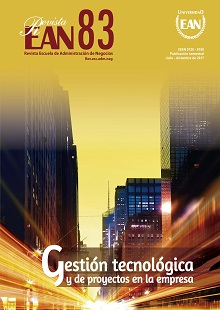Caracterización del rol actual de la mujer en la gerencia de proyectos en Colombia
Characterization of the current role of women in project management in Colombia
Contenido principal del artículo
Resumen
En este estudio, se identifican características de mujeres que desempeñan roles de gerencia de proyectos en Colombia, en general, información sobre sus competencias, habilidades, capacitación, entre otras, a partir de las cuales se puedan proponer acciones que contribuyan a incrementar la participación y a mejorar el desempeño de las mujeres en esta disciplina. El estudio se realizó a partir de la revisión de literatura con información sobre estándares sobre competencias y habilidades de los gerentes de proyectos y de resultados de investigaciones sobre el tema y la participación de mujeres en la gerencia de proyectos. Para este estudio, de enfoque cualitativo, se aplicó un cuestionario estructurado en línea, respondido por veintiún participantes. A partir de la experiencia, se proponen acciones en etapas posteriores de la investigación y en trabajos futuros.
Detalles del artículo
Referencias (VER)
Arditi, D. y Balci, G. (2009). Managerial competencies of female and male construction managers. Journal of Construction Engineering and Management, 135(11), 1275-1278.
Australian Institute of Project Management (2010). AIPM Professional Competency Standards for Project Management Part C-Certified Practising Project Manager (CPPM). Sídney: The Australian Institute of Project Management.
Australian Institute of Project Management (2015). About us. Recuperado de https://www.aipm.com. au/about-us
Botkova, Z. (2008). The Progression of Women in Project Management. Middlesex University.
Burba, D. (2010). Equal ground? They earn less. They’re stereotyped. They have to fight for respect. Are women faring any better in project management? PM Network, 24(9), 38-42.
Crowe, A. (2008). Alpha Project Managers. Kennesaw: Velociteach Press.
El-Sabaa, S. (2001). The skills and career path of an effective project manager. International Journal of Project Management, 19, 1–7.
Giraldo, G. E., Pulido, G. H. y Leal, C. A. (2013). Project Manager Profile Characterization in the Construction Sector in Bogotá, Colombia. Project Management Journal, 44(6), 68-93.
Thornton, G. (2014). Women in business: From classroom to boardroom Grant Thornton International Business Report 2014. Grant Thornton.
Harvard Law School (2015). PON-Program on Negotiation at Harvard Law School. Recuperado de http://www.pon.harvard.edu/category/daily/ negotiation-skills-daily/
Henderson, L. S. y Stackman, R. W. (2010). An exploratory study of gender in project management: Interrelationships with role, location, technology, and project cost. Project Management Journal, 41(5), 37-55.
International Project Management Association (2006). ICB-IPMA Competence Baseline Version 3.0 (3.ª ed.). Nijkerk, The Netherlands: International Project Management Association.
International Project Management Association (2015). About IPMA. Recuperado de http://ipma. ch/about/
Karch, D. M. (2012). Gender-based comparison of project manager leadership behaviours: A quantitative study (Tesis de doctorado, Capella University, Mineápolis, Minnesota).
Kearney, L. y Lloyd, J. (2007). Half of women encounter discrimination at work. Recuperado de http://www. atkinsglobal.com/en-gb/media-centre/news-releases/2007/group/half-of-women-encounter
Kerzner, H. y Salidis, F. (2009). Value-driven project management. Hoboken, NJ: John Wiley y Sons.
Klein, K. E. (2005). ProjectsAtWork-It’s A Woman’s World, Too. Recuperado de https://www. projectmanagement.com/articles/225150/Its-A-Womans-World--Too
Legault, M.-J. y Chasserio, S. (2012). Professionalization, risk transfer, and the effect on gender gap in project management. International Journal of Project Management, 30(6), 697-707. Recuperado de http://linkinghub.elsevier.com/ retrieve/pii/S0263786311001505
Levin, G. (2010). Interpersonal skills for portfolio, program, and project managers. Vienna, VA: Management Concepts.
McCarthy, K. y Burn, P. (2013). The Double Glass Ceiling. Recuperado de https://goo.gl/DVUFnW
Neuhauser, C. (2007). Project manager leadership behaviors and frequency of use by female project managers. Project Management Journal, 38(1), 21-31.
Pant, I. y Baroudi, B. (2008). Project management education: The human skills imperative. International Journal of Project Management, 26, 124- 128.
PMI (2007). Project Manager Competency Development (PMCD) Framework.
PMI (2013a). Guía de los fundamentos para la dirección de proyectos. Newtown Square, Pennsylvania: PMI.
PMI (2013b). Project Management Salary Survey Eighth Edition.
Descargas
Datos de publicación
Declaraciones de autoría
- Sociedad académica
- Universidad Ean
- Editorial
- Universidad Ean









